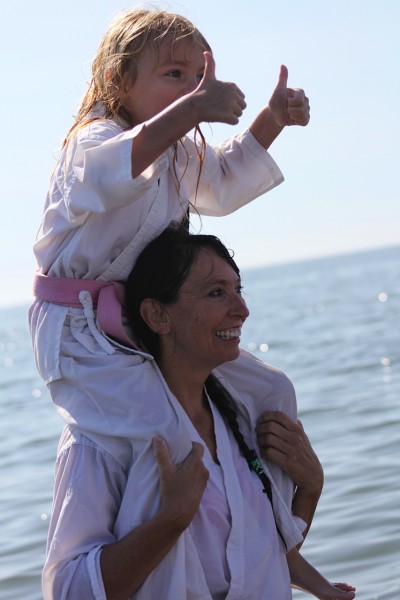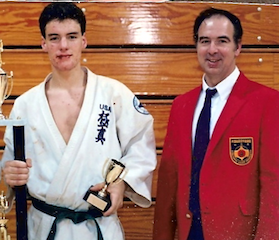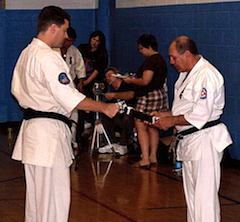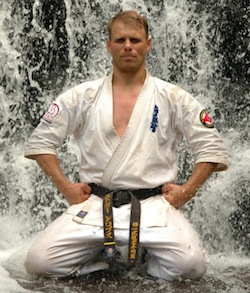About Us
“I feel strength right now just from writing the words. The true feeling is indescribable. This is what I wish to pass on to others.”
Training the Mind, Body, and Spirit
Budo Karate is training for the mind, perhaps even more so than training for physical performance. Our programs are designed to improve focus, awareness, observation, patience, and mental processing. This training is equally important for students of all ages.
Although we emphasize a balanced approach to training your mind and spirit, there is no lack of focus on improving our physical stamina, strength, balance, and agility. Our youth and adult students study Kyokushin karate – an arduous style of martial arts known for its physically strong participants.
While sport and competition is a part of what we do, it is secondary to karate as a means of personal development. Karate is for life. It will help you to be safe, to endure, to succeed, and to grow. It is our goal to create in every student an indomitable spirit to overcome all obstacles and achieve our absolute best.
For All Ages and Abilities

For parents who want their children to develop the skills necessary to stay safe and succeed in life, we have programs for children from pre-school through high school and into adulthood. We provide safe age-appropriate karate training while focusing on the development of attributes that foster success throughout one’s life.
The adults in our school study Kyokushin karate – an arduous style of martial arts known for its full-contact fighting and mentally and physically strong participants. This view can be deceiving at first; appearing to be violent. However, our karate is centered on personal development — and training avenues exist for all people. That development entails seriously practical matters such as real-life self defense and at the same time development of mental and spiritual fortitude. The greatest competition is against oneself, with the self of today pitted against those things about ourselves we wish to overcome or change.
Personally, I can say without hesitation that the greatest gift I have been given through karate is perseverance. There are many other gifts as well, but this one has served me well throughout my life in many circumstances. Never give up. “Fall down seven, get up eight,” 七転八起 (“Nana korobi ya oki”) is a Japanese proverb that tells us that no matter how many times we fall we must get up one more time. Sometimes I want to stay down; it would be so much easier. But something deep inside drives me to stand once again. I have little doubt that the practice of karate fostered this attitude in me. The metaphor of regaining my feet, taking a fighting stance, and raising my arms up in defense is one I visualize during the most trying times of my life. Not only standing, but sinking my weight into the ground, tightening my body into its center, breathing a cleansing breath, and staring into the eyes of my foe. I feel strength right now just from writing the words. The true feeling is indescribable. This is what I wish to pass on to others.
Instructors
Shihan Bob Hopwood
A lifelong martial artist and passionate teacher, Sensei Bob Hopwood began his karate journey in 1984 at the YMCA in Fairfield, Connecticut, under Sensei Ray Martens (one of Soshu Shigeru Oyama’s earliest and most senior students). Immersing himself in the discipline, he trained six days a week and learned the values of respect, perseverance, and resilience. These lessons shaped his approach to life and teaching.

After earning his degree in Computer Science and Engineering from the University of Connecticut, Bob achieved his first black belt (shodan). He earned his second and third degrees (nidan and sandan) under the guidance of Shihan Glenn Learnard, a highly respected practitioner who significantly enriched the Kyokushin curriculum with advanced kata analysis well before it became widely adopted. Bob’s dedication to rigorous training continued over the years, ultimately culminating in his sixth-degree black belt (rokkudan) in 2017, awarded by Shihan Raymond Martens, marking more than three decades of unwavering commitment to the martial arts.

In 2009, Sensei Bob founded Connecticut Budo Karate, a dojo rooted in traditional Kyokushin karate principles. His dojo is a vibrant hub for martial arts training, offering classes five days a week and welcoming students of all ages and abilities.
Beyond karate, Sensei Bob is the co-founder of VolunteerMatters, a leading provider of volunteer management software, helping nonprofits and mission-driven organizations streamline volunteer recruitment, scheduling, and engagement. Despite his demanding professional and family life, Sensei Bob operates the dojo as a labor of love, continually striving to improve his own skills and those of his students. His teaching emphasizes not only physical strength but also self-improvement and the values of budo—the martial way.
Sensei Sue Pacanowski
Sensei Edgar Silovs

“I knew karate would be the thing to bring me back.”
Born in Latvia, Edgar Silovs first began his martial arts journey at the age of 15 by studying from a book. The book, given to him by his father, was in the Russian language and titled Boy’s Karate. Eager for more, in 1992 he responded to an advertisement in a local newspaper for a karate school. Classes were offered in two neighboring towns on alternate days. Edgar started training and went as often as he could, traveling to both towns and training six days a week.
In his first class, the sempai introduced the karate style—Kyokushin—and offered a brief history, including stories of Sosai Oyama. It was then that Edgar realized this was the very same karate in his father’s book. Though Kyokushin was not mentioned, the author of the book was Mas Oyama, and as Edgar explains, “Sometimes life just puts things together for you.”
Edgar immigrated to the United States in 1998. In late 2003, he had a terrible accident that, coincidentally, helped bring him back to karate. While working for a tree service, Edgar fell from a great height and was lucky to survive. After surgery, during which he had metal pins placed in his hip, pelvis, and ankle, his doctor told him that he could no longer practice karate or play ice hockey. It was then that he renewed his search for a school, feeling that “karate would be the thing to bring [him] back.”
He searched the Internet, found our site, and started training in June of 2004. Edgar has represented our dojo in two full-contact tournaments, winning one and placing in another. In January 2010, Edgar successfully passed his shodan test in front of Shihan Ray Martens.
Following his shodan, Edgar remained a dedicated student, training consistently and taking on greater teaching responsibilities at the dojo. He mentored students of all levels, helping them refine their techniques and develop their fighting spirit. His presence became a cornerstone of the dojo, where he not only continued his own rigorous training but also played an essential role in supporting the next generation of martial artists. Whether guiding beginners through their first katas or pushing advanced students in sparring sessions, Edgar was always a steady and inspiring figure.
In 2017, after years of continued dedication to his training, his students, and the dojo, Edgar was awarded his sandan under Shihan Bob Hopwood by Hanshi Ray Martens.
